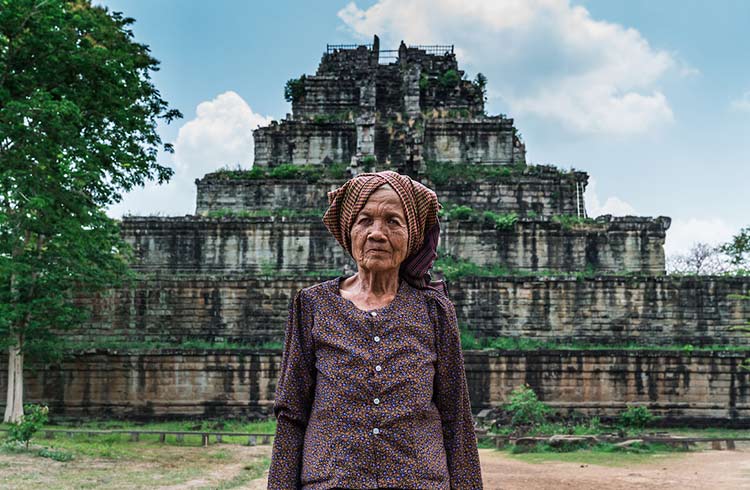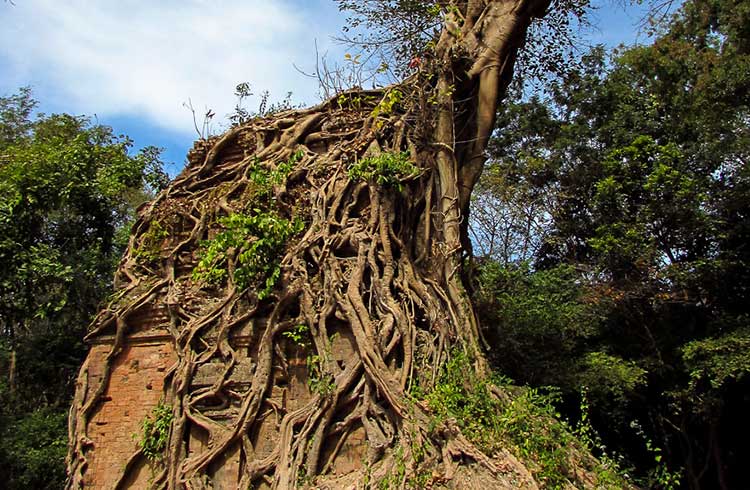Beyond Angkor Wat: Discover 9 Alternative Ancient Sites
Discover Cambodia’s mysterious ancient ruins, crumbling stupas, regal tombs, and faded French architecture. Cassie Wilkins goes beyond the temples of Angkor Wat to reveal Cambodia’s historic sites, off the beaten track.
 Photo © Kelly Beckta
Photo © Kelly Beckta
As the former religous and political center of the ancient Khmer empire, Angkor Wat is deservedly famous. But there are many other temples and sites worth visiting in Cambodia, offering insights into centuries of rich history.
- Phnom Kulen
- Preah Khan of Kampong Svay
- Beng Mealea
- The ancient city of Koh Ker
- Banteay Chhmar
- Prasat Preah Vihear
- Kompong Thom: Sambor Prei Kuk
- Oudong
- Kampot and Kep
- Bokor National Park
Phnom Kulen: The beginning of the Khmer Empire
Just 29mi (48km) from Siem Reap, the little-known historic site of Phnom Kulen is considered the birthplace of the Khmer Empire, where Jayavarman II declared himself the chakravartin, or ‘King of Kings’, in 802 AD.
Lacking the grandeur of the ruined temples of Angkor Wat, this site is interesting for its varied historical sights and natural beauty, including the fascinating carved River of a Thousand Lingas at Kbal Spean; a 1,000-year old sandstone riverbed containing thousands of intricate etchings of fertility symbols and Hindu Gods. It is said that the water flowing over the sacred lingas is ‘blessed’ before it continues on its journey to Angkor and the nearby rice fields before eventually flowing into the Tonle Sap.
In the nearby Phnom Kulen National Park, you’ll also find Cambodia’s largest reclining Buddha, dating back to the 16th century, and an array of small temple ruins, including the Terrace of Sdach Kamlung, a small brick temple that was at one point buried beneath the lava from a nearby volcano.
Preah Khan of Kampong Svay
Step into the shoes of French explorer Louis Delaporte, who is credited with the 1873 rediscovery of this fascinating temple, 62mi (100km) east of Angkor Wat.
Unlike Angkor, not much has really changed since then. There has been some looting, but the site itself is still draped in jungle, with trees growing through the ancient ruins, and the beautiful sandstone bas-reliefs worn by time. Preah Khan of Kampong Svay is the largest temple built during the Angkorian era, with its exterior walls spanning an impressive 1.95m2 (5km2). Thought to have been built in the 11th century, this impressive temple complex includes a 49ft high (15m) pyramid featuring statues of two giant stone elephants, and a Bayon-style four-faced central tower.
Beng Mealea
Located 47mi (77km) away from Siem Reap, on an old road linking Angkor Thom and Preah Khan of Kampong Svay, Beng Mealea is the perfect spot to break up the journey from Siem Reap and enjoy a Tomb-Raider-esque hidden-temple-in-the-jungle-experience.
While you’re free to wander yourself, the best way to explore (and not get lost) is to pay a few dollars to a local guide who will take you on an incredible tour through the jungle and around the ruined city, which was built in the 11th century by Suryavarman II, the builder of Angkor Wat.
The ancient city of Koh Ker

A little further out of the way, but equally worth visiting, Koh Ker was the capital of the Angkor Empire from 928–944 AD and was once home to more than 10,000 people. This forgotten city has long been overgrown by jungle, but that just adds to its mysterious charm. It’s surprisingly easy to lose a day here, exploring all the different sanctuaries, but the highlight is climbing the 131ft-high (40m), seven-tiered pyramid to see the true scope of this mysterious ancient city.
Banteay Chhmar
Closer to the Thai border, the remote and beautiful temple complex of Banteay Chhmar was yet another project of Jayavarman VII – arguably the most famous of the Angkorian kings – and the builder of the empire’s most impressive temples, including Bayon, Angkor Thom, and Ta Prohm.
Banteay Chhmar is most well-known for its spectacular carvings and bas-reliefs, telling the story of the Angkor empire, the princes who came before him, and the historical battles that were won and lost. Although it’s possible to travel from Siem Reap to Banteay Chhmar and back in a day, it’s a long drive so it might be worth breaking up the drive by visiting some of the aforementioned temple sites or heading northeast to Prasat Preah Vihear and staying the night in Sra’Aem.
Prasat Preah Vihear

Located at the top of an impressive 1,722ft high (525m) cliff face along the Thai/Cambodian border, the Angkorian-era temple of Prasat Preah Vihear is a sight to behold.
From the ticket office, you can either hike or opt for a ride on the back of a motorbike or a 4x4 up the mountain, where you will be greeted with beautiful ancient carvings and breathtaking views of the valley and the ancient barays (square-shaped Khmer reservoirs) below.
However, it’s not just the unusual location that makes this temple so unique; Prasat Preah Vihear has also been at the center of a bitter land dispute between Thailand and Cambodia for more than a century. You can see evidence of the skirmishes on the temple itself, with bullet holes in the sandstone and military trenches stretching underneath the ancient ruins.
You can find simple guesthouses 18mi (30km) away in Sra’Aem. The best way to get to Prasat Preah Vihear is to take a taxi from Siem Reap (3.5hrs each way), but you can also join group tours and day trips.
Kompong Thom: Sambor Prei Kuk

Prior to the Angkorian era, before 400BC, Cambodia was part of the Funan Empire, before becoming part of the Chenla Empire later in the 6th century. Some of the ancient cities and temples that exist from this time are even more fascinating than those of the Angkorian era, such as Sambor Prei Kuk, the old capital of King Isanarvaman I.
Only recently declared a UNESCO World Heritage Site, these 7th-century ruins are located just outside of Kompong Thom, on the far eastern bank of the Tonle Sap lake. There are more than 150 temples, overrun by jungle and surrounded by craters from extensive American bombing raids. Despite this, there is still plenty to explore, including brick and sandstone sanctuaries with intricate detailing carvings, like those on the enigmatic Kda Ouk Temple which are believed by many to depict mysterious western-looking men with curly hair and mustaches. Just one of the many mysteries surrounding this ancient site, no one truly knows who they are and how their likenesses ended up on the walls of a small temple buried in the jungle.
Oudong
Following the disintegration of Angkor in the 14th century, the capital of Cambodia was moved to Longvek, and finally in 1618, to Oudong, where it remained for more than 250 years until King Norodom moved to Phnom Penh in 1866.
An easy trip from the modern capital, the abandoned royal city of Oudong is a place of pilgrimage, visited by many Khmers who go to pay their respects to the intricate tombs of former kings and marvel at the beautiful gold stupas.
Although this historic site was extensively damaged during the Khmer Rouge era, it is still well worth a visit, especially for those craving a taste of the real history of the kingdom, far from the tourist trail.
Kampot and Kep
In 1863, Cambodia became a protectorate of France, which ruled over the kingdom as a colonie du exploitation until 1953. Although there are many lasting influences all across the country, one of the most visual is the architecture, especially in the southern cities of Kampot and Kep. The beautiful colonial riverside streets of Kampot are the perfect place to go to relax and unwind.
Nearby Kep, a previously thriving French vacation destination, now has a sleepy, beachside village vibe, but dig a little deeper and you’ll notice crumbling 19th-century mansions and ruins where all that remains of this corner of the French Empire are the elaborate floor tiles and the picture-perfect views.
Bokor National Park

A little way outside of Kampot lies Bokor National Park, where a beautiful drive up to the top of a mountain leads you to an old French town, where wealthy French holidaymakers used to come to escape the heat.
Although the old Bokor Palace Hotel and Casino has recently been renovated to its former glory, there is still a fascinating Catholic church nearby – which was one of the last hideouts of the Khmer Rouge – along with the old holiday home of King Norodom Sihanouk, and the remains of an old cinema and post office.
Related articles
Simple and flexible travel insurance
You can buy at home or while traveling, and claim online from anywhere in the world. With 150+ adventure activities covered and 24/7 emergency assistance.
Get a quote

3 Comments
I recommend another great activity to do in Siem Reap is the Great Escape escape room games! There are 3 games and one is The Lost Room, an Angkor themed mystery room :)
There are some temples and some historical places are there in Cambodia. Rather than that is there any more to be around.
Hi,miss goh Bee geok,interested in the travel to kda ouk temple.
MAY ALL SOULS REST IN PEACE.
LIGHT SHINES UPON HOPE.